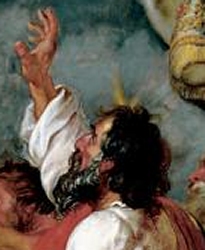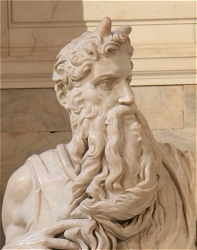Moses and his hornsIn the Ringling Museum's "Gathering of the Manna" painting, as well as in many other 16th and 17th Century paintings and sculpture, Moses was depicted with horns or "rays of light". Also Michelangelo's statue of Moses, in the Church of San Pietro, include horns on his head. It is the result of a mistranslation of the Hebrew Bible into the Latin Vulgate Bible.
The Hebrew word taken from Exodus means either a "horn" or an
"irradiation." Experts at the Archaeological Institute of America show that the
term was used when Moses "returned to his people after seeing as much of the Glory of
the Lord as human eye could stand," and his face "reflected radiance." In
early Jewish art, moreover, Moses is often "shown with rays coming out of his
head."
|


